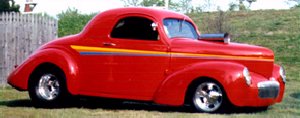The Willys-Overland Company
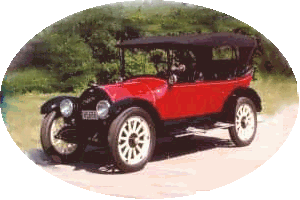
John North Willys bought the Overland Automotive Division of Standard Wheel Company in 1908 and in 1912 named it the Willys-Overland Motor Company. Willys-Overland made both automobiles and trucks. The company was reorganized in 1936 after a depression bankruptcy to Willys-Overland Motors, Inc. Some of the coolest street rods are built from pre-WW2 Willys cars. The 1940 Willys Coupe below was for sale when I found the picture.
The Birth of the Jeep
As the war in Europe spread in the late '30s, the U.S. Military wanted a new light-weight, four-wheel-drive, reconnaissance vehicle. They solicited bids for command/reconnaissance car with an 80" wheelbase and weighing 1300 lbs in June of 1940. Three companies responded: Bantam, Ford and Willys. The Bantam Car Company had the leading contender based on overall design, but Willys had the wonderful "Go Devil" flat-head four cylinder engine. Ford had some good ideas too and there was a pooling of ideas that surely violated the spirit, if not the letter, of intellectual property, trade-mark, and other laws, but served the governments needs. The final winner after a few resubmittals was the GPW. "G" for government, "P" for pigmy (a Ford term) and "W" for Willys.One story has it that the lowly, uninformed GI's thought "GP" was for general purpose, and pronounced it "jeep". Other people say that the word "jeep" was slang for any wonderfully multipurpose thing. The Popeye cartoon had a character, named "Eugene the Jeep" in 1936, who had all kinds of amazing powers. Anyway, the source of the name "Jeep" is now vailed by the passage of time... but on with the story.
The government selected a vehicle based mostly on the design by the Bantam Car Company. Bantam didn't have the mass production facilities needed to supply the government, and the military wanted multiple suppliers. Willys got a contract to build "jeeps" in late 1940. Ford was also awarded a contract a week later. Many parts were interchangeable between the Willys and Ford jeeps. Of the roughly half million jeeps produced for WW2, Willys-Overland made about 360,000 between 1941 and 1945. The jeeps proved to be rugged and dependable in the war, and by the time the soldiers came home, jeeps were well known and loved for their durability and unstoppability. (More details are available in The Jeep, a Real American Hero .)
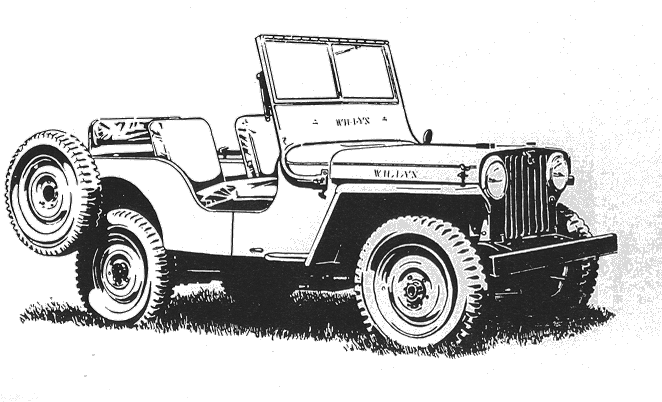
After the War
Willys-Overland was not one of the automotive giants in the prewar era, and had retooled most of their production facilities to jeeps. After the war, production of passenger cars continued, but the company couldn't ignore the potential civilian market for jeeps. They filed for a trademark registration of "Jeep" and began production. The most direct product transition was the CJ (Civilian Jeep) line. This product was little changed from those that had "won the war". The first CJ-2A was produced in 1945. The line has continued from the CJ2 through the CJ3, CJ5, CJ6, CJ7,and CJ8. (They did make a CJ4 but it was only a prototype that never went into production.) The CJ5 and CJ7 are the most common, with the CJ7 being a little longer than the CJ5. The CJ6 and CJ8 were longer wheel base than the CJ7, but they weren't as popular, and consequently there were fewer of them manufactured. I think there was a CJ10, but it wasn't sold in the US.| Model | Years | Quantity | |
| CJ-2A | 1945 - 1949 | 214k | |
| CJ-3A | 1946 - 1953 | 132k | |
| CJ-3B | 1952 - 1968 | 155k | |
| CJ-5 | 1954 - 1983 | 611k | |
| CJ-6 | 1955 - 1981 | 50k | |
| CJ-7 | 1976 - 1986 | 379k | |
| CJ-8 | 1981 - 1986 | 28k | |
| Thanks to Tom Wanamaker, Jeff Hanselman, Joe Schaefer | |||
The postal Jeeps are designated as DJ for Dispatcher Jeep. They are 2WD and most are right hand controls.
The Wrangler (YJ & TJ) are direct descendents of the CJ line, so I guess you can say that the original Jeep line is still going. But since 1963 Jeeps have been manufactured by Kaiser, AMC, and Chrysler. So I'm getting side-tracked from the Willys story.
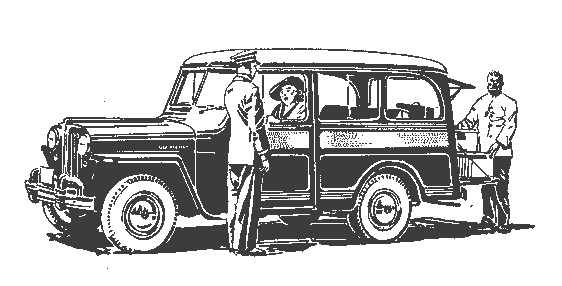
The Willys
Back in those post-war years, Willys-Overland tried to broaden their market by returning to the car and truck business, in addition to the CJ's. Their products were nothing like the smooth, graceful pre-war products. Instead they capitalized on the tough, utilitarian image of the Jeep with three new vehicles: the Willys Jeep Wagon in 1946, the Willys Jeep Truck in 1947, and the Willys Jeepster in 1948.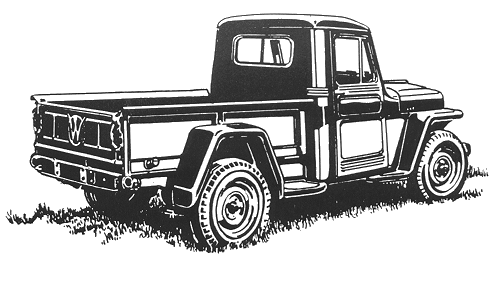
These were called the 'Jeep' Utility Vehicles and all retained clear influences of the military Jeep, but the forms were intermediate between the normal rounded forms of the autos of the period and the boxy Jeep. The wagon was similar to the panel trucks or delivery wagons of the day, but with those unmistakable flat fenders (and later 4WD). The truck was similar in size and functionality of a GMC, Ford or Dodge truck of the day, but once again with the Jeep look and available in 4WD.
The Jeepster was a convertible about half-way between a military Jeep and a sports car. This two wheel drive vehicle was only made from 1948 to 1950, but was resurrected by AMC in the '60's as the Jeepster Commando. Some people point out that the Jeepster was technically a phaetom, not a convertible. A phaeton was a type of two-door touring car without a solid top. To the common man, phaeton doesn't mean much. 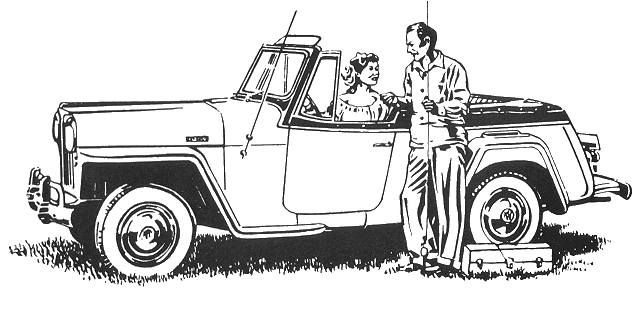
The wagon and pickup truck were available in both 2WD and 4WD with a 4-cylinder or 6-cylinder engine. Kaiser bought Willys-Overland in 1953 and dropped "Overland" from the name. In the 1956, Willys introduced snub-nosed forward control models. Production of Willys wagons and trucks continued under the name of the Willys Motor Company until 1963, when the name was changed to the Kaiser-Jeep Corporation. Production of the Willys wagons and trucks continued for two more years until 1965. Willys had production facilities in Brazil, Argentina, Israel, and India, and Japan . Some of these continued making vehicles that were essentially the same as the Utility vehicles for several more years. But eventually Kaiser sold these. Thus ended the production of those interesting vehicles we call Willys.
If the folks at Willys had known that driving in the dirt was a sport, they would have called them Sport Utility Vehicles, but they didn't, so they were dubbed simply Utility Vehicles. It is up to those of us who came latter to make a sport of driving them. The Willys Utility Wagon is clearly the grand daddy of all modern SUV's. It was a 4WD wagon with enough space inside to load up and go most anywhere.
| Model | Years | Quantity |
| Wagons | 1946 - 1965 | over 300k |
| Trucks | 1947 - 1965 | over 200k |
| Jeepster | 1948 - 1950 | 19k |
| Thanks to Tom Wanamaker | ||

What's in a Name
The original pronunciation of "Willys" was with a short "i" sound for the 'y"; so it was pronounced "Will-iss". But it seems to have been transmuted by the same flexibility of language that could produce "Jeep" out of "GP". I've heard that the workers in the Willys factories were the first people to mispronounce the name. Like most everyone I have every talked with, they pronounced it with a long "e" sound for the "y". The official DMV title for my truck lists the make as a "Willy". (They only have space for five characters on the title.) From that, people guess that one vehicle must be a Willy, pronounced "Willie", which is as good a nickname for William as is Bill. So "Willys" would be pronounce "Will- eez" and obviously be more than one "Willy". Everyone seems to get more and more confused over time. Even my insurance agent asked me if there was an "e" before the "y". I guess I add to the confusion. I often say "Will-eez" as a nickname for those unique trucks and wagons produced from 1946 until 1965.Kaiser bought Willys (1953), AMC bought Kaiser (1970), and Chrysler bought AMC (1987). Then Chrysler merged with Daimler in 1998. The Germans who lost the war to the Jeep now own it!
Since the company is no more, who is to tell me I'm saying its name wrong - the Germans?
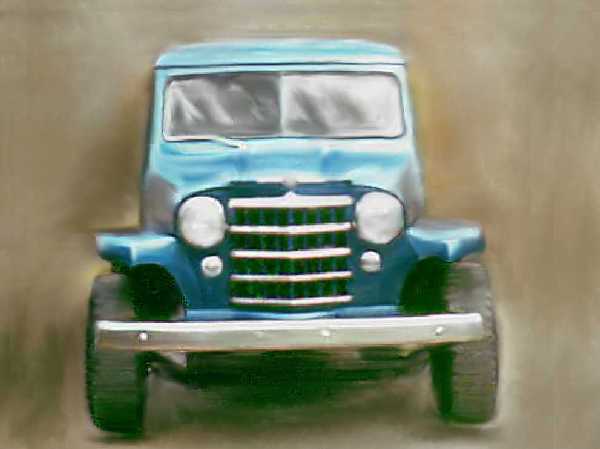
Rendering from a photo of Ken's 1950 2WD pickup.
